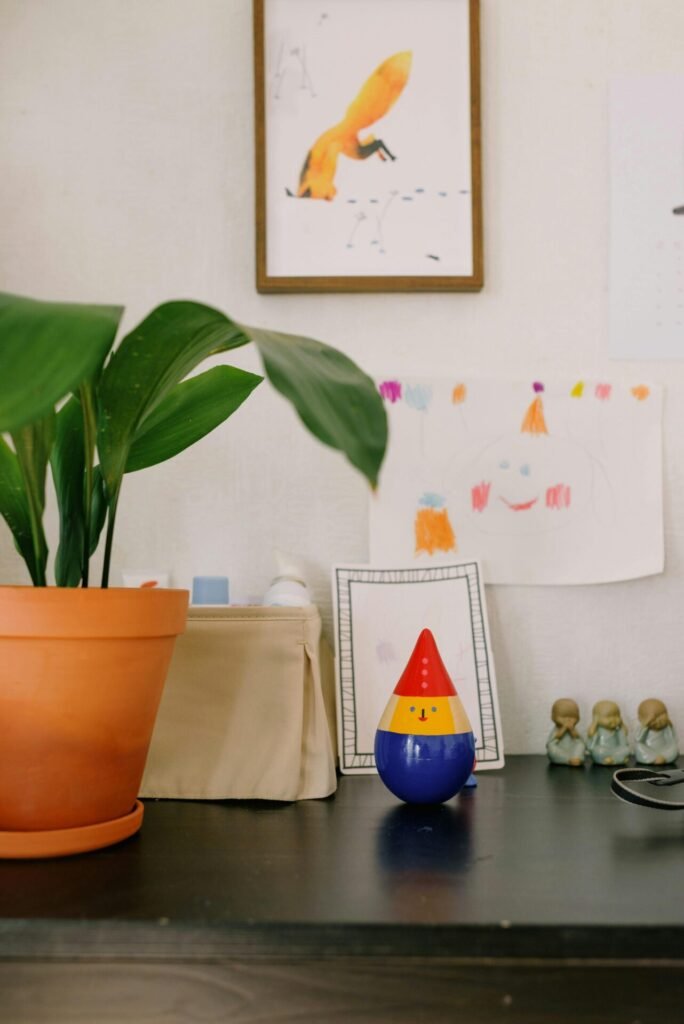Children’s artwork is more than just colorful scribbles—it’s a window into their imagination, growth, and emotional world. But as the masterpieces pile up, many parents struggle with how to display them without cluttering their home or damaging the originals. This guide offers smart and stylish solutions for showcasing your child’s art in ways that honor their creativity while keeping your space organized and visually appealing.
Why Displaying Kids’ Art Matters
Displaying your child’s artwork isn’t just about decoration—it’s about validation. When kids see their creations honored in the home, it boosts their confidence, encourages self-expression, and fosters a lifelong love of creativity.
Emotional Benefits
- Encourages Self-Worth: Children feel proud when their work is seen and appreciated.
- Supports Development: Art display reinforces storytelling, visual thinking, and emotional expression.
- Strengthens Family Bonds: Sharing and discussing artwork creates meaningful moments.
Common Challenges in Displaying Children’s Art
While the intention is heartfelt, the execution can be tricky. Parents often face:
- Overwhelm: Endless drawings and paintings can quickly take over walls and surfaces.
- Damage Risk: Tape, sunlight, and humidity can degrade paper and pigment.
- Aesthetic Balance: Integrating kids’ art into a cohesive home design can be challenging.
Smart & Stylish Display Solutions
Here are practical, creative ways to showcase your child’s art without sacrificing style or space.
Create a Rotating Gallery Wall
Designate a wall or hallway as a mini gallery. Use clipboards, magnetic frames, or hanging wires with clips to make swapping art easy.
- Benefits: Keeps the display fresh and manageable.
- Style Tip: Choose uniform frames or neutral backdrops to maintain visual harmony.
Use Digital Archiving and Displays
Scan or photograph your child’s artwork and display it digitally on a tablet frame, smart TV slideshow, or printed photo book.
- Benefits: Preserves originals while reducing clutter.
- Style Tip: Curate themed collections (e.g., animals, seasons) for visual impact.
Incorporate Art into Functional Decor
Turn artwork into usable items like throw pillows, mugs, calendars, or tote bags using online print services.
- Benefits: Makes art part of daily life.
- Style Tip: Choose pieces with bold colors or patterns for maximum effect.
Frame Select Pieces with Care
Choose a few standout works to frame professionally or with DIY materials. Use UV-protective glass and acid-free mats to preserve longevity.
- Benefits: Elevates the art and protects it.
- Style Tip: Mix children’s art with adult pieces for an eclectic gallery wall.
Use Art Ledges or Shelves
Install shallow shelves to hold framed or mounted artwork. This allows for easy rotation and layering.
- Benefits: Flexible and space-saving.
- Style Tip: Keep shelf styling minimal to let the art shine.
Create an Art Binder or Portfolio
Store flat pieces in a labeled binder or archival portfolio. This keeps the collection organized and accessible.
- Benefits: Preserves work without wall space.
- Style Tip: Let your child decorate the cover for a personal touch.
Designate a Creative Corner
Set up a small area with cork boards, magnetic panels, or string-and-clip systems where kids can curate their own mini exhibitions.
- Benefits: Empowers kids to choose and display their favorites.
- Style Tip: Use coordinated colors or frames to keep the area tidy.
Preserving Artwork for the Long Term
If you want to keep your child’s art for years to come, consider these preservation tips:
- Avoid Direct Sunlight: UV rays fade colors and weaken paper.
- Use Archival Materials: Acid-free paper, sleeves, and mats prevent deterioration.
- Store in Climate-Controlled Spaces: Avoid attics or basements with humidity fluctuations.
- Digitize Regularly: Scanning ensures you have a backup of every piece.
Involving Your Child in the Process
Let your child help choose which pieces to display, rotate, or archive. This builds decision-making skills and gives them ownership of their creative journey.
- Ask for Their Favorites: What do they feel proud of?
- Let Them Curate Themes: Animals, family, seasons, or imaginary worlds.
- Celebrate Milestones: Display art from birthdays, holidays, or school projects.

Sketchbooks.org | DIGITAL MATERIALS
Best Adobe Sketching Software for Digital Drawing & Illustration | Tools & Features
Adobe has revolutionized the digital art space with powerful software designed for sketching, drawing, and illustration. Whether you're an aspiring artist or a seasoned professional, Adobe's tools offer seamless workflows, advanced brushes, and AI-powered enhancements...
Frequently Asked Questions
How do I display my child’s art without damaging it?
Use frames, clips, or archival sleeves to protect artwork from tape, sunlight, and moisture.
What’s the best way to organize kids’ artwork?
Create a rotating display system and archive older pieces in binders or digital folders.
Can I turn my child’s art into home decor?
Yes, many services allow you to print artwork on pillows, mugs, and other items.
How often should I rotate the art on display?
Monthly or seasonally works well to keep the space fresh and engaging.
Is it okay to throw away some of my child’s art?
Yes, but consider digitizing it first and involve your child in the decision.
What materials help preserve artwork long-term?
Use acid-free paper, UV-protective frames, and climate-controlled storage.
How do I make a gallery wall for kids’ art?
Use matching frames or clip systems on a dedicated wall or hallway.
Should I frame every piece?
No—select a few standout works and rotate others using clips or ledges.
Can I display art in shared family spaces?
Absolutely—children’s art adds warmth and personality to living rooms and kitchens.
Final Thoughts
Showcasing your child’s art at home doesn’t have to mean cluttered walls or damaged drawings. With thoughtful strategies and stylish solutions, you can celebrate their creativity while maintaining a balanced, beautiful space. Whether you choose rotating displays, digital archives, or functional decor, the key is to honor your child’s imagination in a way that fits your lifestyle. Let their art be a joyful part of your home’s story.
Ready to Share Your Work?







